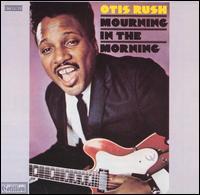Blues Great Records His First Elpee
This Otis Rush love fest, produced by Mike Bloomfield and Nick Gravenites at Fame in Muscle Shoals, Alabama, was payback for the generosity and help Rush provided the youngsters back in Chicago during their "formative" years. Led by The Paul Butterfield Blues Band, the white suburban audience that formed the core of the "counter-culture" had discovered the blues. Butterfield had backed Dylan at Newport in 1965, causing a big stir, and soon thereafter Mike Bloomfield and drummer Sam Lay were in the studio with Dylan to record Highway 61 Revisited.
By the time this record was made, in 1969, two years had passed since Gravenites had formed The Electric Flag, a horn-drenched, blues-rock-psychedelic "American music" band that included Bloomfield. The group recorded the soundtrack to the psychedelic film The Trip, followed by Long Time Comin'. Bloomfield quit shortly thereafter.
Meanwhile, the long-play album revolution was peaking, and even if The Rolling Stones, these guys, and some others had revived the blues and brought the electrified Chicago spur of it to a white audience, how much of that audience had actually heard it played by the original masters?
Rush, who'd essentially been a singles artist (on Cobra) and had had his greatest success in the mid to late 1950s, had never made an album. Using their newfound leverage, Gravenites and Bloomfield got Rush signed to Cotillion, a small subsidiary of Atlantic, and brought their hero down to Fame to record his first album. By then the Muscle Shoals studio had become a familiar venue for Atlantic Records.
Since Rush had been under the tutelage of Willie Dixon, who wrote, produced, arranged, and played bass on most of Rush's great singles (including his most famous, "I Can't Quit You Baby"), Bloomfield and Gravenites provided many of the tunes here. Neither played, though--instead they put Rush in front of the famous Muscle Shoals session team, which included a young Duane Allman before he'd formed his own group. Also on board was keyboardist Mark Naftalin, who'd been in the Butterfield band. But the main sound here is horn-drenched Dixie--closer to Stax-Volt than to Chess or the "West Side Sound," which makes sense since the producers were obviously trying to get Rush some well-deserved commercial success using a sound that was then white-hot.
The star here is Rush's fluid guitar playing and his mellifluous voice, which shines above some of the pedestrian "pick-up band" arrangements and less-than-stellar song choices. Gravenites and Bloomfield had their hearts in the right place, but skilled A&R men they were not. At least they weren't at the time of this session, though it must be said that they penned the set's highlight, "Reap What You Sow" (which includes the album title in its lyrics).
Rush does contribute two tunes, "Love Will Never Die" and "It Takes Time," both of which have an urban retro feel. Don't expect to hear Duane Allman's upper-register fretboard squeals on this record, though. This was Rush's album, and the other guitarists stay respectfully in the background. The final tune, "Can't Wait No Longer," with its "black chick" background vocals and pulsing horns, shows where Rush might have taken his sound had the album been commercially successful. It smokes.
Sonically, this recording is barely competent. Whether by design or accident, Rush's voice on side one sounds distorted, echoey, and distant--as if the producers or the engineer were trying to mimic the raw sound of the Cobra sessions, which were recorded under less-than-ideal conditions but which nevertheless contributed to a unique and very commercial sound. Some tracks sound better than others, but it all sounds like four-track recordings mixed hard-left/-right and center. I'm making it sound worse than it really is so you won't be disappointed (the faults lie in the recording, not the mastering, which is fine). Crank it up and you'll enjoy this slice of musical history. Meanwhile, if you want to hear Rush's Cobra singles, check out The Essential Otis Rush, The Classic Cobra Recordings 1956-1958 (Fuel Records/Varése Sarabande 302 061 077 2).
- Log in or register to post comments




